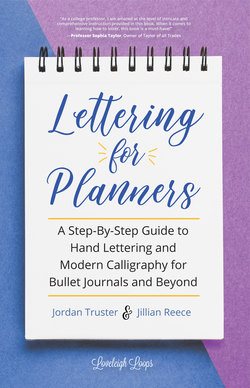Читать книгу Lettering for Planners - Jillian Reece - Страница 7
На сайте Литреса книга снята с продажи.
ОглавлениеOne of our favorite things about lettering is that you can use it anywhere you’d like! Since there’s a limited amount of space on every page, though, it would be hard to fit in every word with decorative lettering. So here we have suggested some places that work best:
Page Titles (e.g. “Future Log”)
The main title of a page is one of the best places to add lettering. Why? Because titles are usually short, important, and larger than the rest of the words on the page. Titles are meant to stand out, and lettering is a great way to make them pop. Plus, since most titles are only a few words, they’re less overwhelming to tackle than an entire paragraph.
Section Headers (e.g. “Mood Tracker”)
Sections within a page or spread, such as a habit tracker, can get lost if there are a lot of notes or doodles around it. Lettering your headers is a great way to define each section and convey what it’s all about. Making the words “Water Tracker” or “Exercise Log” look fancier may even make you more excited to reach your goals!
Lists (e.g. “Books to Read,” “Healthy Meal Ideas”)
Similar to section headers, list titles are usually very specific, which makes them a great place to add lettering. The words can be decorated to match the theme of the page, and spending time lettering them makes them harder to forget.
Full-Page Quotes or Dividers (e.g. “Summer!” or a full quote)
An entire page that’s dedicated to a quote or lyric is like a giant blank canvas for your lettering! This works especially well with a longer quote because you can pick the most important words to letter, and write the other words in a plain style. A full-page divider, such as the start of a new month or season, is also a prime place to set the tone for that month’s theme using hand-lettered details.
Monthly and Daily Spreads
The names of the months and days of the week have always been some of our favorite words to letter. There’s so much you can do, such as flourishing the “y” at the end of each “–day”. Plus, they’re familiar words that are comfortable to write, and since they appear frequently, you can try out different styles each month.
Special Occasions and Holidays
(e.g. “Sister’s Birthday”, “Merry Christmas”)
Celebrate special moments by beautifying the letters in your journal or planner. You can use colors and style to make them more special, such as writing “Our Anniversary” in a romantic script, or using black and orange for some edgy Halloween letters.
The Cover
The cover is the perfect place to add a personalized touch, like your name or a meaningful quote. Depending on the material of your planner, you may need to use something other than a regular pen. Permanent markers, paint, and embossing powder are great for non-paper covers, but we recommend practicing with a pencil before writing directly on it with something permanent.
Tips
For each of these opportunities, we have some advice. The most important is to take your time. Lettering should be enjoyable, and the more relaxed and focused you are, the more pleased you’ll be with the results.
We also recommend sketching with pencil before inking over it, especially when you’re first getting started. We’ve made plenty of spelling mistakes that are hard to fix when they’re inked. Plus, sketching will help you measure the spacing and ensure that you don’t run out of room.
Lastly, think about the size of your words in relation to their importance. You may consider page titles to be very important, whereas section headers are of secondary importance. More significant words can stand out if you make them larger. For example, if you use a dot grid journal, you could make page titles twice as tall as section headers by doubling the number of grid spaces used for the letter height.
Overall, remember that this is your journal. There are no “rules” about where you can or can’t use lettering, and it’s ultimately your choice how to incorporate this skill into your daily life.
Takeaways
•Go big! Larger text is easier to letter and decorate than small text.
•Keep it simple starting out and focus on short phrases.
•Pick important words that you want to emphasize, rather than decorating “boring” words (unless,
of course, you want to make something boring more exciting).
•Sketch your lettering in pencil before inking over it so you’re not nervous about spacing issues or spelling errors.
